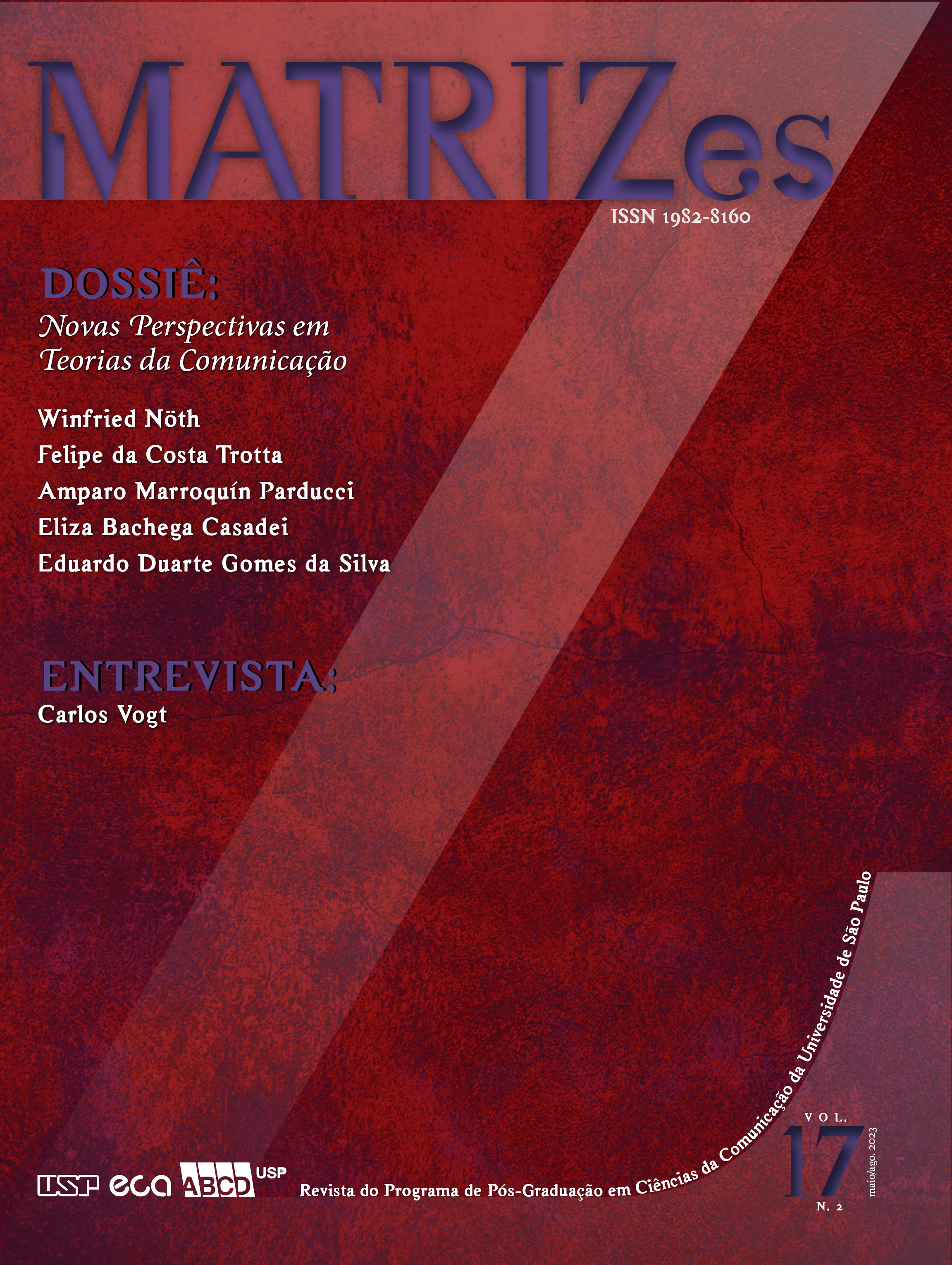The thermographic narrative in Incoming and There Will be no More Night
DOI:
https://doi.org/10.11606/issn.1982-8160.v17i2p257-276Keywords:
Image, Artistic appropriation, RefugeesAbstract
Incoming (2017), by photographer and filmmaker Richard Mosse, is a multi-channel art installation that is based on the thermal detection system of a powerful and restricted military surveillance camera, adapted by Mosse to observe refugee camps in southern Europe. There Will Be no More Night (2020), a film by filmmaker Éléonore Weber, triggers records of military operations filmed from a war aircraft in tracking and attack actions, using thermal images from pilots’ helmets. This study analyzes the artistic appropriation processes of the immersive and multi-screen format produced by artist Richard Mosse and the use of military archives in cinematographic modulation, used as technological clothing and surveillance images in the documentary by director Éléonore Weber.
Downloads
References
Beiguelman, G. (2021). Políticas da Imagem: Vigilância e Resistência na Dadosfera. Ubu editora.
Brink, J., & Oppenheimer, J. (2012). Killer Images. Documentary Film, Memory and the Performance of Violence. Columbia University Press.
Català, J. M. (2012). El Murmullo de las Imágenes. Shangrila.
Chouliaraki, L., & Tijana, S. (2017). Rethinking media responsibility in the refugee crises: a visual typology of European news. Media, Culture & Society, (39). http://journals.sagepub.com/doi/abs/10.1177/0163443717726163.
Comolli, J.-L. (2006). A última dança: como ser espectador de Memory of the Camps. Devires, 3(1). http://fafich.ufmg.br/devires/index.php/Devires/article/view/261.
Daney, S. (1991). Montage obligé. La guerre, du Golfe et petit écran. Cahiers du Cinéma, 442. https://www.cahiersducinema.com/produit/serge-daney/
Demos, T. J. (2013). The migrant image. The art and politics of documentary during global crisis. Durham University Press.
Didi-Huberman, G., & Giannari, N. (2017). Pasar, cueste lo que cueste. Shangrila.
Farocki, H. (2013). Desconfiar de las Imágenes. Caja Negra.
Honess Roe, A. (2013). Animated Documentary. Palgrave Macmillan.
Huyssen, A. (2014). Culturas do Passado-Presente: Modernismos, Artes Visuais, Políticas da Memória. Contraponto.
Jones, R. (2016). Violent borders: refugees and the right to move. Verso.
Lavoie, V. (2020). Qual visualidade para o êxodo em massa. Revista Interin, 25(2). https://interin.utp.br/index.php/i/article/view/2400
Levi, P. (1990). Os afogados e os sobreviventes. Paz e Terra.
Martin, N. (2019). As index and metaphor: Migration and the Thermal Imaginary in Richard Mosse’s Incoming. Culture Machine, 17. https://culturemachine.net/vol-17-thermal-objects/as-index-and-metaphor/
Mosse, R. (2017). Incoming. Mack.
Nash, M. (2005). Inmigrantes en nuestro espejo: inmigración y discurso periodístico en la prensa española. Icaria Antrazyt.
Santos, A. C. L., & Teixeira, R. T. (2019). Sobre paisagens conhecidas e corpos anônimos: memórias fotográficas do fluxo migratório no Mediterrâneo. Revista Rumores, 13(25). https://www.revistas.usp.br/Rumores/article/view/148356
Saugmann, R. (2019). Military techno-vision: Technologies between visual ambiguity and the desire for security facts. European Journal of International Security, 1. Cambridge University Press.
Snow, J. Richard Mosse on the refugee crisis. Channel4.com. https:www.channel4.comnewsrichard-mosse-on-the-refugee-crisis
Tramontana, F. (2018). The conversation: migrants have crossed the mediterranean for centuries but they used to head from north to south. The Conversation, 2(1). https://theconversation.com/migrants-have-crossed-the-mediterranean-for-centuries-but-they-used-to-head-from-north-to-south-97287
Weber, E. (2020). There will Be no More Night. https://www.youtube.com/watch?v=5CBJgANNYjE.
Downloads
Published
Issue
Section
License
Copyright (c) 2023 Rafael Tassi Teixeira

This work is licensed under a Creative Commons Attribution-NonCommercial-ShareAlike 4.0 International License.
Authors who publish in this journal agree to the following terms:
- Authors retain the copyright and grant the journal the right to first publication, with the work simultaneously licensed under the Creative Commons Attribution License (CC BY-NC-SA 4.0) which allows sharing of the work with acknowledgment of authorship and initial publication in this journal for non-commercial purposes.
- Authors are authorized to assume additional contracts separately, for non-exclusive distribution of the version of the work published in this journal (eg, publishing in institutional repository or as a book chapter), with acknowledgment of authorship and initial publication in this journal.






















